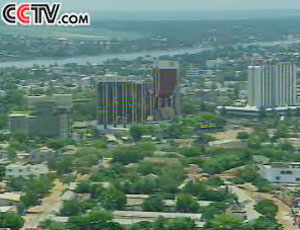Source: CCTV.com
10-24-2006 17:28
 |
We have been travelling along the Atlantic coast from Ghana into Togo and have now reached Lomé, the capital city of the nation.
Togo is a long, narrow strip stretching 600 kilometers from the Gulf of Guinea in the south to its northern borders and is only 60 kilometers across from the east to the west.
Lomé is the biggest port city of Togo and center of the nation's political, economic and cultural activities. From the days of the slave trade, and the trade in table salt and cocoa, Togo has played a key role in contact between the east and west, both by land and ocean.
Most of the country lies in mountains except for a strip making up a narrow plain along the coast but the plains gradually give way to mountains as one moves northwards and there, in those mountains, some indigenous tribes have retained their traditional ways of life .
 |
The Kabre people make up the second largest ethnic group in Togo with some 500 thousand Kabre people still living in this northern mountainous area which is their ancestral land. Every year in late July, the people hold a wrestling competition for young men who have reached their 18th birthday. This is, in fact, their initiation ceremony.
It's now April and we are eager to watch the ceremony so we go and asked the chief if the villagers can put on a wresetling competition especially for us.
The tribes elect their chief and he has his sovereignty and prerogatives recognized by the state. The chief we turned to granted our request but added that the wresetling contest is regarded as a divine event in the Kabre tradition and must be observed strictly in accordance with the rites.
Before the contest each competing family performs rites of ancestral worship. Spirits of the ancestors dwell in these clay loaves, each of which represents a forefather. The elder of the family talks to the clay as if he is talking to a family member.
Then the headman comes forth, invokes the ancestors dwelling in the clay, and pours a libation.
Sacrifice is also performed as part of the ceremony and the feathers in the clay are the result of these repeated acts of worship. For big events such as this these clay loaves are moved carefully and respecfully out of their niches and then worshiped. The white cock flutters its wings, an occurrance which the local people believe is a sign of the ancestors welcoming their guests. They chant cheers and applaud.
 |
The women are preparing a local food, a favorite of the indigenous people, made from boiled yam mixed with cassava. This food is to be served to the wrestlers after the contest.
When the chicken is ready, it is presented to the ancestors first, together with a bowl of corn wine.
The ancestors are supposed to eat first so they will then help and protect the family. The chicken is served together with the yam-cassava food and seasonings. Each one of the ancestors is treated with solemnity.
After the worship the clay loaves are sent back to the niches. The board fence at the entrance keeps out the cats and dogs.
Editor:Wang Ping
